Hanuman Janmotsav : “Day of Celebration of Birth of Lord Hanuman”
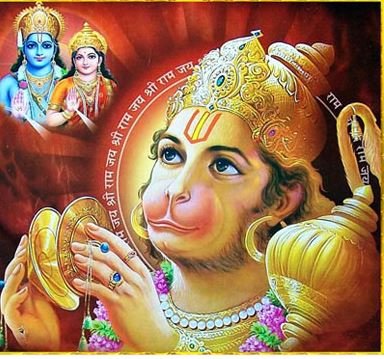

|| मनोजवम् मारुततुल्यवेगम् जितेन्द्रियम् बुद्धिमताम् वरिष्ठम्।
वातात्मजम् वानरयूथमुख्यम् श्रीरामदूतम् शरणं प्रपद्ये ||
Manojavam Marutatulyavegam Jitendriyam Buddhimatam Varishtham।
Vatatmajam Vanarayuthamukhyam Shriramadutam Sharanam Prapadye॥
Hanuman Janmotsav is one of the famous Hindu festivals that is celebrated for the birth of Hanuman, the greatest disciple of Bhagwan (Lord) Ram who himself is an incarnation of Vishnu for his selfless service and courage.
Hanuman Ji also appears in Buddhism, Sikhism as well as in Jainism.
Hanuman Janmotsav is held in the month of Chaitra (mid-March to mid-April) or Vaisakha (mid-April to mid-May).
Chaitra Purnima is a widely accepted day in most North Indian states to observe the birth anniversary of Lord Hanuman.
Lord Hanuman is the son of Mata(mother) Anjana and Pita (father) Kesari. He is also called the son of “Vayu Deva” i.e., the wind god.
Hanuman Ji is considered a symbol of Power and great strength in Hindu scriptures. He is believed to have carried a whole mountain on his shoulder.
Hanuman Ji is a key figure in the Hindu scripture Ramayana, which describes Rama’s war with the demon king Ravana, who abducted his wife. Hanuman Ji led his monkey army against Ravana and played a key role in saving Rama’s wife Sita.
In Ramayana, the extraordinary role of Lord Hanuman is an exemplary devotee of Lord Rama and is very well detailed in situations requiring strength, willpower, and courage.
Hanuman Ji showed his unconditional love for Lord Ram, who also blessed him and reciprocated his devotion by treating him like a brother.
Lord Hanuman’s character is lyrically elaborated in Tulsidas’s “Hanuman Chalisa‘” Also invoked as ‘Sankat Mochan’, Lord Hanuman can avert any ill effects posed by the nine planets on one’s life as well as save one from the influence of evil spirits.
In the Hindu faith, Tuesdays and Saturdays are dedicated to the worship of Lord Hanuman to get his blessings for progress, wisdom, and fearlessness.
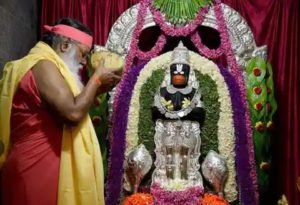
As per Hindu scriptures, Hanuman Ji was born at sunrise, so recitations and poring over religious texts are done at dawn and later ‘prasad’ distribution ceremony is held.
Hanuman Janmotsav festival involves worship, offerings, mantra chanting, and other devotions.
During Hanuman Janmotsav, devotees visit Hanuman Ji temples and apply a red tilak (mark) to their foreheads called sindoor in honor of him. Devotees also observe a day-long fast on Hanuman Janmotsav. Devotees also do Shodasho-Pachara Puja.
Devotees organize special prayers for Lord Hanuman to get rid of evil spirits. Hanuman Ji is known for its magical powers. Prayers and Hymns are sung all day long in various Hanuman temples dedicated to the lord. Hanuman is considered a symbol of Power and great strength in the Hindu faith.
Important puja rituals include offering red vermillion with ghee to the idol of Hanuman. Red flowers, rui leaves with areca nut, fruits especially bananas, laddoos are offered and divas are lit.
In Western India, the practice of fasting a day before the Hanuman Janmotsav is prevalent, whereas in Northern India, the general practice is to observe fasting on the day Hanuman Janmotsav is held. Also, it is far more popular among males, especially wrestlers, and bodybuilders.
Devotees recite the Hanuman Chalisa 108 times and Bajrang Baan and perform ‘Hanuman Ji Arti’. It is believed that chanting the Hanuman Chalisa 108 times for hundred days can help one attain the four tenets of Dharma, Artha, Kama, and Moksha.
Temple priests also share prasad (food presented as an offering), which may include sweets or fruits.
Lord Hanuman is the embodiment of courage, self-control, the highest state of devotion, intellect, sense-control, and humility. Hanuman Janmotsav is the most auspicious time to worship him to imbibe all his great qualities in our human capacity which in a real sense is not possible.
It is also true that Lord Hanuman can grant extraordinary powers to a ‘Sadhak’ earnestly seeking his blessings on his spiritual journey. The saffron flag near the Hanuman temples on the highways and the hilly regions is a sign of protection against the possibility of any untoward incident or evil energies. Hanuman Ji is called “Chiranjeevi” as he has the boon of immortality, and it is believed to exist to date.
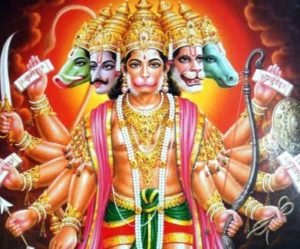
When Maa Sita was abducted by Ravana, Hanuman Ji could locate the place of captivity of Mata Sita and used his intellect and power to build an army to reach Lanka and save Maa Sita. Some of the most daring and noticeable episodes in the Ramayana include the burning of Lanka with his tail, and bringing an entire mountain that had ‘Sanjeevani’ or life-saving herbs to save Lakshman’s life.
There is a story about the meeting of Bheem and Lord Hanuman in Mahabharat in which Hanuman Ji by his trick shatter proud of the egoistic Bheem.
|| ॐ ऐं भ्रीम हनुमते,
श्री राम दूताय नम: ||
Aum Aeem Bhreem Hanumate
Shree Ram Dootaaya Namaha
Meaning – I bow in front of Lord Hanuman, who is the greatest server and messenger of the Lord Sri Rama.
Benefits of chanting the Hanuman Beej mantra
|| ॐ श्री हनुमते नमः ||
Om Shri Hanumate Namah
Meaning – I bow in front of Lord Hanuman.
Benefits of chanting the Hanuman Moola Mantra
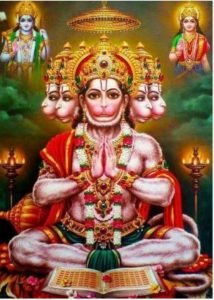
|| ॐ आञ्जनेयाय विद्महे वायुपुत्राय धीमहि।
तन्नो हनुमत् प्रचोदयात् ||
Om Anjaneyaya Vidmahe Vayuputraya Dhimahi।
Tanno Hanumat Prachodayat॥
Meaning – We pray to the son of Goddess Anjani and the son of the Wind. May Lord Hanuman lead our intellect towards intelligence and knowing.
Benefits of chanting the Hanuman Gayatri mantra
ॐ श्री वज्रदेहाय रामभक्ताय वायुपुत्राय नमोsस्तुते ।
Om Shree Vajradehaya Ramabhakthaya Vayuputhraya Namosthuthe
Meaning – I bow before Lord Hanuman who has a body made of the vajra, who is a devotee of Lord Ram and the son of wind (Vayu).
Benefits of chanting the Anjaneya mantra
Hanuman Janmotsav is celebrated in most states at different times and in different parts of India.
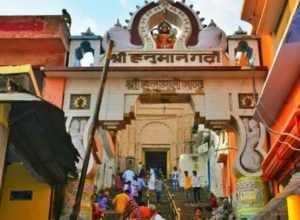
For some communities, Hanuman Janmotsav is the precursor to Diwali, as it is celebrated a day before Diwali.
I Wish All Hanuman Devotees a Blessed Hanuman Janmotsav !!!
DISCLAIMER: The author is solely responsible for the views expressed in this article. The author carries the responsibility for citing and/or licensing of images utilized within the text.
